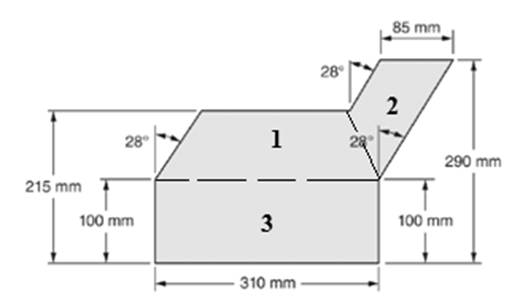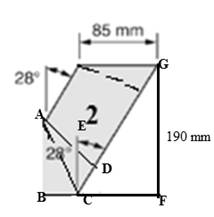
The area of the template.
Answer to Problem 64A
Area
Explanation of Solution
Concept used:
The template is divided into two trapeziums and a rectangle as shown.

The area of two trapeziums and the area of rectangle are added to find the required area.
Calculation:
Area of trapezium (1),

Here, height h = 215 − 100 = 115 mm, base b1= 310 mm and
Base (b2) is calculated as:
Since the groove makes an angle of 28° then, the angle made by the triangle is,
Thus, from symmetry the base of another triangle is also 61.2 mm.
Now, the base b2 of the trapezium is:
Substituting the above values in the formula;
Again, Area of trapezium (2),

Here, height h = 85 mm,
Base b1is calculated as:
Since the groove makes an angle 28°, then the
Hence,
Again, From the geometry of the figure the line BCE makes an angle of 90° and
Now, the combined
Thus, from symmetry the base of another triangle is also 57.33 mm.
Now, the base b2 of the trapezium is:
Substituting the above values in the formula;
Area of rectangle
Here, length l = 310 mm and Width w = 100 mm
By substituting the above values in the formula;
Now, Adding the equations (1), (2), and (3) to calculate the required area.
Thus,
Conclusion:
Thus, the area of the given template is
Want to see more full solutions like this?
Chapter 57 Solutions
EBK MATHEMATICS FOR MACHINE TECHNOLOGY
- [) Hwk 25 4. [-/4 Points] Hwk 25 - (MA 244-03) (SP25) || X Answered: Homework#7 | bartle X + https://www.webassign.net/web/Student/Assignment-Responses/last?dep=36606604 DETAILS MY NOTES LARLINALG8 6.4.019. Use the matrix P to determine if the matrices A and A' are similar. -1 -1 12 9 '-[ ¯ ¯ ], ^ - [ _—2—2 _ ' ], ^' - [ ˜³ −10] P = 1 2 A = -20-11 A' -3-10 6 4 P-1 = Are they similar? Yes, they are similar. No, they are not similar. Need Help? Read It SUBMIT ANSWER P-1AP = 5. [-/4 Points] DETAILS MY NOTES LARLINALG8 6.4.023. Suppose A is the matrix for T: R³ - → R³ relative to the standard basis. Find the diagonal matrix A' for T relative to the basis B'. A' = -1 -2 0 A = -1 0 0 ' 0 02 B' = {(−1, 1, 0), (2, 1, 0), (0, 0, 1)} ☐☐☐ ↓ ↑ Need Help? Read It Update available →] - restart now ASK YOUR T Sync and save data { Sign In ill ↑ New tab HT New window N New private window +HP ASK YOUR T Bookmarks History Downloads > > HJ Passwords Add-ons and themes HA Print... HP Save page as... HS…arrow_forwardClarification: 1. f doesn’t have REAL roots2. f is a quadratic, so a≠0arrow_forward[J) Hwk 25 Hwk 25 - (MA 244-03) (SP25) || X Answered: Homework#7 | bartle X + https://www.webassign.net/web/Student/Assignment-Responses/last?dep=36606604 1. [-/4 Points] DETAILS MY NOTES Find the matrix A' for T relative to the basis B'. LARLINALG8 6.4.003. T: R² → R², T(x, y) = (x + y, 4y), B' = {(−4, 1), (1, −1)} A' = Need Help? Read It Watch It SUBMIT ANSWER 2. [-/4 Points] DETAILS MY NOTES LARLINALG8 6.4.007. Find the matrix A' for T relative to the basis B'. T: R³ → R³, T(x, y, z) = (x, y, z), B' = {(0, 1, 1), (1, 0, 1), (1, 1, 0)} A' = ↓ ↑ Need Help? Read It SUBMIT ANSWER 具⇧ ASK YOUR TEACHER PRACTICE ANOTHER ill ASK YOUR TEACHER PRACTICE ANOTHER 3. [-/4 Points] DETAILS MY NOTES LARLINALG8 6.4.013. ASK YOUR TEACHER PRACTICE ANOTHERarrow_forward
- Use Laplace transforms to solve the following heat problem: U₁ = Urr x > 0, t> 0 u(x, 0) = 10c a -X u(0,t) = 0 lim u(x,t) = 0 I7Xarrow_forwarda/ Solve the equation Laplac transfors wt = wxx W (X10)=0 w (o,t) = f (t) lim wexit) = 0 *>° t>o , to t70 848arrow_forwardQ/ Find the Fourier sine and cosine trans forms of f(x) = e-cxarrow_forward
- Q/Find the Fourier sine and cosine transforms of f(x) = Xe-Xarrow_forwardQ/solve the equation Laplac transforms:- x>0, to 43 1 иху u cx,α) = f(x) и a Cort ) = • lim u(x,t) = 0 8700 و X>0 , toarrow_forwardPlease conduct a step by step of these statistical tests on separate sheets of Microsoft Excel. If the calculations in Microsoft Excel are incorrect, the null and alternative hypotheses, as well as the conclusions drawn from them, will be meaningless and will not receive any points. The data for the following questions is provided in Microsoft Excel file on 4 separate sheets. Please conduct these statistical tests on separate sheets of Microsoft Excel. If the calculations in Microsoft Excel are incorrect, the null and alternative hypotheses, as well as the conclusions drawn from them, will be meaningless and will not receive any points. 1. One Sample T-Test: Determine whether the average satisfaction rating of customers for a product is significantly different from a hypothetical mean of 75. (Hints: The null can be about maintaining status-quo or no difference; If your alternative hypothesis is non-directional (e.g., μ≠75), you should use the two-tailed p-value from excel file to…arrow_forward
 Holt Mcdougal Larson Pre-algebra: Student Edition...AlgebraISBN:9780547587776Author:HOLT MCDOUGALPublisher:HOLT MCDOUGAL
Holt Mcdougal Larson Pre-algebra: Student Edition...AlgebraISBN:9780547587776Author:HOLT MCDOUGALPublisher:HOLT MCDOUGAL Glencoe Algebra 1, Student Edition, 9780079039897...AlgebraISBN:9780079039897Author:CarterPublisher:McGraw Hill
Glencoe Algebra 1, Student Edition, 9780079039897...AlgebraISBN:9780079039897Author:CarterPublisher:McGraw Hill Mathematics For Machine TechnologyAdvanced MathISBN:9781337798310Author:Peterson, John.Publisher:Cengage Learning,
Mathematics For Machine TechnologyAdvanced MathISBN:9781337798310Author:Peterson, John.Publisher:Cengage Learning,- Algebra & Trigonometry with Analytic GeometryAlgebraISBN:9781133382119Author:SwokowskiPublisher:Cengage
 Elementary Geometry For College Students, 7eGeometryISBN:9781337614085Author:Alexander, Daniel C.; Koeberlein, Geralyn M.Publisher:Cengage,
Elementary Geometry For College Students, 7eGeometryISBN:9781337614085Author:Alexander, Daniel C.; Koeberlein, Geralyn M.Publisher:Cengage, Trigonometry (MindTap Course List)TrigonometryISBN:9781337278461Author:Ron LarsonPublisher:Cengage Learning
Trigonometry (MindTap Course List)TrigonometryISBN:9781337278461Author:Ron LarsonPublisher:Cengage Learning





